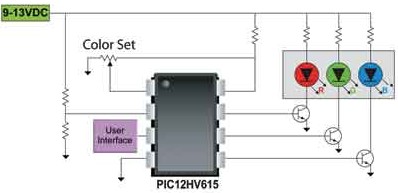The new energy-efficient, more powerful new LED solid-state lighting (SSL) products are rapidly evolving and are considered to be major revolutionary advances in the lighting market. In many vertical applications, such as signal lights, automotive, LCD TV backlights, LEDs have become an alternative to traditional light sources without any controversy. But for a wider range of general-purpose lighting, LEDs have not been widely accepted, and their applications will lag behind these vertical applications for years. The cost and efficiency of solid state lighting products will undoubtedly continue to improve rapidly and will soon reach the widely accepted threshold, possibly in 2007 or 2008, and others believe that it will be postponed until around 2010.
Solid state lighting products in general lighting
The reason for hindering this transfer is that the capacity of a traditional market is too large, and the second is the inertia of the market. To meet backward compatibility is probably the biggest challenge. Thermal management, voltage conversion, and color management are fundamental issues that need to be addressed. As more and more people in the industry begin to recognize these issues, they need to adopt intelligent digital control methods to cost-effectively solve a variety of challenges before they can enjoy the benefits of new technologies.
Interesting efficiency figures
According to officials at ENERGY STAR (http://), if the United States uses LEDs as an efficient lighting method, the nation’s electricity demand will be reduced by more than 10%, saving taxpayers $17 million. The expenditure, which reduces CO2 emissions by 200 million tons, is equivalent to a reduction of 15 million cars.
If LED lighting is used on buildings, it can save 48% of lighting power. The luminous efficiency of an incandescent lamp is generally 10 ~ 15lm / W, the efficiency of fluorescent lamps can reach 70 ~ 100lm / W, the efficiency of xenon lamp is 80 ~ 120lm / W, the current efficiency of commercial LED is 80lm / W, some experiments The product has reached 131lm/W, and the maximum theoretical efficacy of LED is 200lm/W.
White is not color
The biggest problem with LEDs is that the frequency band of the light is very narrow, so that the color of the light is very simple, can achieve high efficiency, and does not generate heat. If the color of light is exactly what we want, of course, in general lighting, all we need is white light. In other words, what we need is a mixture of multiple colors in a certain proportion to mimic the spectrum of sunlight filtered through the Earth's atmosphere.
White light can be obtained by applying a layer of phosphorous material to the blue or ultraviolet source of the LED. All LED manufacturers are conducting extensive research on the composition, thickness and location of phosphorus-containing materials.
LED manufacturers continue to announce new research results, saying that the new devices are more efficient than any previous product. In addition, the quality of the light source is constantly improving. The quality of the light we see in our eyes can be measured by the correlated color temperature (CCT), which is the temperature of the black body that best matches the perceived color of the lamp.
Mix colors appropriately
Another way to get a white LED is to mix the three colors of red, green, and blue (RGB) in the correct ratio, not only to get white light, but also to achieve the desired color temperature. Figure 1 shows the application circuit for this method, using an 8-pin 8-bit MCU to control the tri-color RGB LED. With a simple algorithm, the relative intensity of the three LEDs can be controlled to achieve a resolution of 6 bits (64 intensity levels), which is sufficient for controlling the color output and the associated color temperature.
The circuit uses a PIC12HV615 flash MCU, a voltage divider resistor, a reset circuit, and an A/D converter. The oscillator provides an 8MHz clock to form a simple single-chip solution. In production, color calibration can also be performed using the circuit programmable features of such flash memory devices.
LED life
The circuit shown in Figure 1 is suitable for many applications, but one important drawback is its low efficiency. This is a linear solution where power is consumed in the ballast resistor. In addition, more problems may occur throughout the product life cycle.

Figure 1 White LED system for color calibration
   One of the main advantages of LEDs is their extremely long service life, which also poses a serious problem, namely color cast. The LED can be used for more than 50,000 hours, and its luminous intensity will gradually drop from the nominal value to about 70% (the incandescent lamp will suddenly fail after about 1,500 hours of use).
Unfortunately, within this 50,000 hours, the correlated color temperature (CCT) of a white LED will change. As the phosphor ages, the CCT will drift to a higher temperature, that is, to the blue. Similar problems arise with RGB LEDs when the three color illuminators age according to different curves.
By using a microcontroller, plus a predictive algorithm or a closed-loop control system, several techniques will be developed to compensate for the effects of device aging. Some growers have already produced color light-sensitive components, and with a simple PID algorithm, the color drift problem can be completely solved at one time. Of course, the use of such components will increase the cost.
Since the color drift process is very slow, high computational performance is not required, and even low-cost 8-bit MCUs can meet the requirements.
